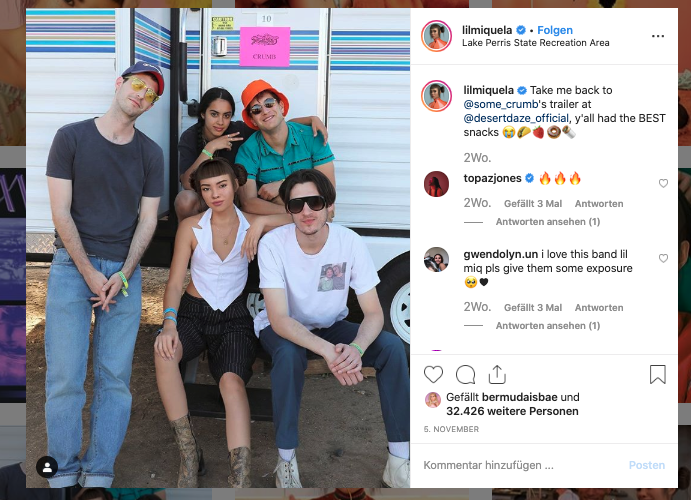
I am currently working on the trendy topic of “virtual influencers”. At first I had a funny gut feeling about this topic. Influencers and YouTubers thrive on being real, authentic people in a “real” world with real thoughts and feelings that they share with their community. They influence their community, letting them participate in their lives and immerse themselves in their world. But it should be clear to everyone by now that influencers in 2020 are no longer (just) personalities who sit in front of their webcam in their (children’s) bedrooms and talk. And my sentence about the genuineness and authenticity of influencers is, at least in many cases, probably unsurpassable in naivety.
Many influencers create an almost perfect world and provide insights into their oh-so-exciting lives, which in many cases does not correspond at all to what they actually lead. Staging is everything. I also find myself sharing more and more often on my Instagram account @danwithsomebody, of course, only the great and exciting things with my followers. Because I’m exclusively having fun and experiencing one great thing after another.
And it is precisely this point that has led me to be much more open to the topic of “Virtual Influencer” and even to discover and enjoy numerous opportunities in this field.
But what is a “virtual influencer” anyway?
Virtual influencers are animated or artificially created avatars or personalities. Most of the time, these virtual people mimic classic influencers, and their profiles are in no way inferior to the big players in the industry in terms of quality and staging. Often you can see the “artificiality” on them, usually even quite consciously. One of the best-known examples is probably the influencer (and musician) @lilmiquela, who already has almost 1.7 million subscribers on Instagram. With her, the general public initially thought that her artificial look was a way of putting on makeup or editing the pictures. It was only after 2 years that they dropped the bombshell and officially announced that it didn’t actually exist and was computer generated. In this context, the band “Gorillaz” comes to my mind – because Miquela also starts as the singer of a band.
There are many other examples of virtual influencers and even model agencies that bring their “artificial models” together with companies. Basically, these virtual personalities, to which interests, opinions, goals and much more are then added for character formation, can present anything we want. Moon Boots wear on the moon? Present the new bikini collection while diving with vicious sharks? No problem at all.
All it takes is an avatar with a presence on Instagram and a digitized version of the product to be included – as well as a setting.
If you look at many virtual influencers and see their “artificiality,” the avatars always seem more real, and often you may not see them until you look at the 3. or 4. look that the said “person” might be artificial after all.
Opportunities and risks?
Yes, the topic is new and innovative. But it’s not that new, is it? In advertising, products have been promoted with animated mascots for decades. So we are not that fresh here – just adapted to the currently most relevant communication platforms. However, from my point of view, what is much more interesting is what opportunities, but also risks, could arise behind this “new world”.
From an advertising perspective, product placements can take place in an exciting environment and in an innovative way. Virtual influencers can relatively easily experience, meet, discover and promote what and who we want. Be it in the context of products, fashion, or even employers, travel and places, vehicles and much more. They wear the latest H&M collection, live in an apartment furnished by IKEA, of course – and go on vacation in the most beautiful hotels in the world.
If the virtual personalities do not belong to the brand but to an agency, the buyouts and model fees no longer go to the models but to the developers or rights holders.
Companies can produce motifs for campaigns and online stores much faster, more freely and (in perspective) more cost-effectively, and this digital process means that the product doesn’t even have to be physically present. Digitization makes it possible.
But virtual influencers can be more than just another advertising space. I could also imagine them in the context of “opinion leaders”. They can represent a point of view or values behind which they can stand much more easily and emphatically than real people – because the virtual personality does not need to fear a shitstorm or even physical attacks. So a virtual Greta could communicate much more extreme.
The opportunities and risks are blurring. The meaning of terms like “authenticity” and “genuineness” is inflationary. Whether you like the picture of a person who stages everything anyway or the content of a virtual personality doesn’t make much difference. To put it bluntly, I wouldn’t be surprised if an artificially created person developed more personality and profile than a real one.
How the whole issue will be received in Germany is anyone’s guess. And here it is probably rather obvious that we, typically German, (will) react skeptically and cautiously to this trend – quite in contrast to users from Asia and the USA.
Personally, I’m looking forward to the many opportunities that will come in using this new “influencer genre” and will have more to report on this topic soon – first hand.
Read more:
- https://interestingengineering.com/9-virtual-influencers-taking-over-the-internet
- https://www.absatzwirtschaft.de/virtual-influencer_sei_echt_kuenstlich-163493/
- https://www.gruenderszene.de/perspektive/lil-miquela-brud-millionen?interstitial_click
Daniel Goihl | Managing Director TACSY GmbH | www.tacsy.tv
www.instagram.com/danwithsomebody
